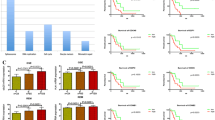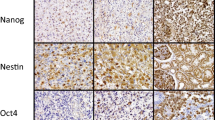Abstract
Using the novel tissue microarray technique, we studied immunohistochemical expression of cell cycle regulators p53, p21, pRb in 42 grade II oligodendrogliomas, 16 grade III anaplastic oligodendrogliomas, 10 primary and 4 recidive grade II oligoastrocytomas, 10 grade III oligoastrocytomas and 2 other grade II mixed gliomas. The p53 immunopositivity associated with malignant histology of the tumor (p = 0.01, Mann–Whitney test) and high pRb expression (p = 0.015). The p21 score associated strongly with histological grade (p 0.001). The immunopositive tumors had a significantly higher rate of proliferation (p = 0.021). The p21 immunopositivity correlated positively with p53 immunopositivity: among the 33 p21 immunopositive tumors 30 (91%) were p53 immunopositive and only 3 were p53 immunonegative (p = 0.017). Patients with p21 immunonegative primary tumors had significantly better prognosis: among them 42 of the 46 (91%) survived, whereas only 18 of the 30 patients (60%) with p21 immunopositive primary tumors survived until the follow-up date (p = 0.0017). Statistical significance was reached in multivariate analysis as well (p = 0.01, exp(B) = 5.5). The pRb immunopositive tumors had higher proliferation rate than immunonegative tumors (p = 0.002). In multivariate variance analysis, comparing the effects of different regulatory proteins on cell proliferation, only the amount of pRb expression reached statistical significance (p = 0.004). In conclusion, the expression of p21 in oligodendrocytic tumors seems to be upregulated by p53 expression which rises with cell proliferation and malignancy as in attempt to halt cell cycle but seems to be overrun by other factors. The amount of p21 expression has independent prognostic significance and could be used in diagnosis to help the difficult evaluation of the malignancy potential of oligodendrogliomas and oligoastrocytomas.
Similar content being viewed by others
References
Kraus JA, Koopmann J, Kaskel P, Maintz D, Brandner S, Schramm J, Louis DN, Wiestler OD, von Deimling A: Shared allelic losses on chromosomes 1p and 19q suggest a common origin of oligodendroglioma and oligoastrocytoma. J Neuropathol Exp Neurol 54(1): 91–5, 1995
Maintz D, Fiedler K, Koopmann J, Rollbrocker B, Nechev S, Lenartz D, Stangl AP, Louis DN, Schramm J, Wiestler OD, von Deimling A: Molecular genetic evidence for subtypes of oligoastrocytomas. J Neuropathol Exp Neurol 56: 1098–104, 1997
Perry JR, Louis DN, Cairncross JG: Current treatment of oligodendrogliomas. Arch Neurol 56(4): 434–6, 1999
Dirks PB, Rutka JT: Current concepts in neuro-oncology: the cell cycle - a review. Neurosurgery 40(5): 1000–15, 1997
Bartek J, Lukas J, Bartkova J: Perspective: defects in cell cycle control and cancer. J Pathol 187(1): 95–9, 1999
Ginsberg D, Mechta F, Yaniv M, Oren M: Wild-type p53 can down-modulate the activity of various promoters. Proc Natl Acad Sci USA 88: 9979–83, 1991
Kastan MB, Onyekwere O, Sidransky D, Vogelstein B, Craig RW: Participation of p53 protein in the cellular response to DNA damage. Cancer Res 51: 6304–11, 1991
Kuerbitz SJ, Plunkett BS, Walsh WV, Kastan MB: Wildtype p53 is a cell cycle checkpoint determinant following irradiation. Proc Natl Acad Sci USA 89: 7491–5, 1992
Pavelic J, Hlavka V, Poljak M, Gale N, Pavelic K: p53 immunoreactivity in oligodendrogliomas. J Neuro-Oncol 22: 1–6, 1994
El-Deiry WS, Tokino T, Velculescu VE, Levy DB, Parsons R, Trent JM, Lin D, Mercer WE, Kinzler KW, Vogelstein B: WAF1, a potential mediator of p53 tumor suppression. Cell 75: 817–25, 1993
Harper JW, Adami GR, Wei N, Keyomarsi K, Elledge SJ: The p21 Cdk-interacting protein Cip1 is a potent inhibitor of G1 cyclin-dependent kinases. Cell 75: 805–16, 1993
Brugarolas J, Chandrasekaran C, Gordon JI, Beach D, Jacks T, Hannon GJ: Radiation-induced cell cycle arrest compromised by p21 deficiency. Nature 377: 552–7, 1995
Waldman T, Kinzler KW, Vogelstein B: p21 is necessary for the p53-mediated G1 arrest in human cancer cells. Cancer Res 55: 5187–90, 1995
Michieli P, Chedid M, Lin D, Pierce JH, Mercer WE, Givol D: Induction ofWAF1/CIP1 by a p53-independent pathway. Cancer Res 54: 3391–5, 1994
Parker SB, Eichele G, Zhang P, Rawls A, Sands AT, Bradley A, Olson EN, Harper JW, Elledge SJ: p53-independent expression of p21Cip1 in muscle and other terminally differentiating cells. Science 267: 1024–7, 1995
Arvanitis D, Malliri A, Antoniou D, Linardopoulos S, Field JK, Spandidos DA: Ras p21 expression in brain tumors: elevated expression in malignant astrocytomas and glioblastomas multiforme. In Vivo 5: 317–21, 1991
Jung JM, Bruner JM, Ruan S, Langford LA, Kyritsis AP, Kobayashi T, Levin VA, Zhang W: Increased levels of p21WAF1/Cip1 in human brain tumors. Oncogene 11: 2021–8, 1995
Korkolopoulou P, Kouzelis K, Christodoulou P, Papanikolaou A, Thomas-Tsagli E: Expression of retinoblastoma gene product and p21 (WAF1/Cip 1) protein in gliomas: correlations with proliferation markers, p53 expression and survival. Acta Neuropathol 95: 617–24, 1998
Koopmann J, Maintz D, Schild S, Schramm J, Louis DN, Wiestler OD, von Deimling A: Multiple polymorphisms, but no mutations, in the WAF1/CIP1 gene in human brain tumours. Br J Cancer 72: 1230–3, 1995
Friend SH, Bernards R, Rogelj S, Weinberg RA, Rapaport JM, Albert DM, Dryja TP: A human DNA segment with properties of the gene that predisposes to retinoblastoma and osteosarcoma. Nature 328: 643–6, 1986
Weinberg R: The retinoblastoma protein and cell cycle control. Cell 81: 323–330, 1993
Toguchida J, Ishizaki K, Sasaki MS, Nakamura Y, Ikenaga M, Kato M, Sugimot M, Kotoura Y, Yamamuro T: Preferential mutation of paternally derived RB gene as the initial event in sporadic osteosarcoma. Nature 338: 156–8, 1989
Harbour JW, Lai SL, Whang-Peng J, Gazdar AF, Minna JD, Kaye FJ: Abnormalities in structure and expression of the human retinoblastoma gene in SCLC. Science 241: 353–7, 1988
Lee EY, To H, Shew JY, Bookstein R, Scully P, Lee WH: Inactivation of the retinoblastoma susceptibility gene in human breast cancers. Science 241: 218–21, 1988
Henson JW, Schnitker BL, Correa KM, von Deimling A, Fassbender F, Xu HJ, Benedict WF, Yandell DW, Louis DN: The retinoblastoma gene is involved in malignant progression of astrocytomas. Ann Neurol 36: 714–21, 1994
Broholm H, Bols B, Heegaard S, Braendstrup O: Immunohistochemical investigation of p53 and EGFR expression of oligodendrogliomas. Clin Neuropathol 18: 176–80, 1999
Kros JM, Godschalk JJ, Krishnadath KK, Van Eden CG: Expression of p53 in oligodendrogliomas. J Pathol 171(4): 285–90, 1993
Ohgaki H, Eibl RH, Wiestler OD, Yasargil MG, Newcomb EW, Kleihues P: p53 mutations in nonastrocytic human brain tumors. Cancer Res 51(22): 6202–5, 1991
Kononen J, Bubendorf L, Kallioniemi A, Barlund M, Schraml P, Leighton S, Torhorst J, Mihatsch MJ, Sauter G, Kallioniemi OP: Tissue microarrays for high-throughput molecular profiling of tumor specimens. Nat Med 4: 844–7, 1998
Theillet C: Full speed ahead for tumor screening. Nat Med 4: 767–8, 1998
Moch H, Schraml P, Bubendorf L, Mirlacher M, Kononen J, Gasser T, Mihatsch MJ, Kallioniemi OP, Sauter G: Highthroughput tissue microarray analysis to evaluate genes uncovered by cDNA microarray screening in renal cell carcinoma. Am J Pathol 154: 981–6, 1999
Bubendorf L, Kolmer M, Kononen J, Koivisto P, Mousses S, Chen Y, Mahlamaki E, Schraml P, Moch H, Willi N, Elkahloun AG, Pretlow TG, Gasser TC, Mihatsch MJ, Sauter G, Kallioniemi OP: Hormone therapy failure in human prostate cancer: analysis by complementary DNA and tissue microarrays. J Natl Cancer Inst 91: 1758–64, 1999
Kleihues P, Burger PC, Scheithauer BW: Histological Typing of Tumours of the Central Nervous System. WHO. Berlin: Springer-Verlag, 1993
Sallinen P, Haapasalo HK, Visakorpi T, Helén P, Rantala IS, Isola JJ: Prognostication of astrocytoma patient survival by Ki-67 (MIB-1), PCNA, and S-phase fraction using archival paraffin-embedded samples. J Pathol 174: 275–82, 1994
Reifenberger J, Ring GU, Gies U, Cobbers L, Oberstrass J, An HX, Niederacher D, Wechsler W, Reifenberger G: Analysis of p53 mutation and epidermal growth factor receptor amplification in recurrent gliomas with malignant progression. J Neuropathol Exp Neurol 55(7): 822–31, 1996
Author information
Authors and Affiliations
Rights and permissions
About this article
Cite this article
Miettinen, H.E., Paunu, N., Rantala, I. et al. Cell Cycle Regulators (p21, p53, pRb) in Oligodendrocytic Tumors: a Study by Novel Tumor Microarray Technique. J Neurooncol 55, 29–37 (2001). https://doi.org/10.1023/A:1012961918848
Issue Date:
DOI: https://doi.org/10.1023/A:1012961918848




